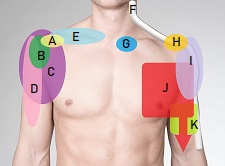- Home
- Common Shoulder Problems
- Biceps Tendonitis
Biceps Tendonitis
Written By: Chloe Wilson BSc (Hons) Physiotherapy
Reviewed By: SPE Medical Review Board
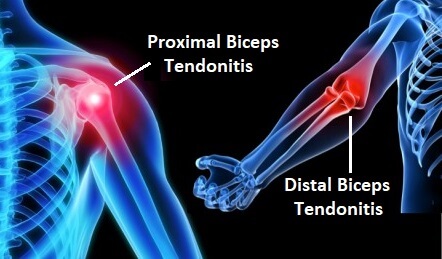
Biceps tendonitis is a common problem affecting the shoulder or elbow where degeneration and/or inflammation of one of the biceps brachii tendons results in arm pain.
Biceps tendonitis typically affects athletes between the ages of 18-35 and non-athletes over the age of 65. It typically causes pain in the upper arm and is made worse by repetitive overhead activities.
Biceps tendinopathy is known by various different names including biceps tendinitis, biceps tendinopathy, bicipital tendonitis and bicipital tendinitis – they all basically refer to the same thing!
Most cases of biceps tendinopathy will settle down within a few weeks with simple treatment such as rest, physical therapy and strengthening and stretching exercises. In some cases, steroid injections or surgery may be advised.
Here we look at the common causes of biceps tendonitis and what is going on in the tendon itself, common symptoms and the best treatment options to help you make a full recovery so you can get back to the things you love.
Biceps Anatomy
The biceps brachii muscle, more commonly referred to as just “the biceps”, is a long muscle that spans the front of the upper arm. It is a two-headed muscle, meaning that it originates from two different areas of the shoulder blade:
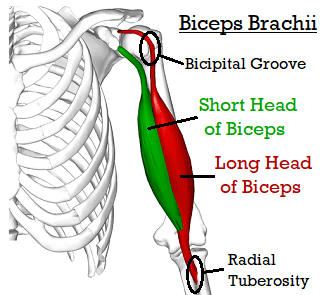
- Long Head of Biceps: Supraglenoid tubercle and down the bicipital groove
- Short Head of Biceps: Coracoid process
These two heads join together mid-upper arm to form the bulk of the biceps muscle before attaching to the forearm just below the elbow to the radial tuberosity.
What Is Biceps Tendonitis?
There are three biceps tendons, two at the shoulder and one at the elbow and biceps tendonitis can develop in any of these three tendons known as:
- Proximal Biceps Tendonitis: in either the long head or short head tendons at the shoulder
- Distal Biceps Tendonitis: at the elbow
Tendons are thick, cord-like structures that attach muscles to bone. Biceps tendonitis is where there is irritation and/or micro-tearing in one of the biceps brachii tendons which leads to inflammation. The damaged bicep tendon gradually thickens and becomes more inflamed, resulting in pain and weakness. In some cases, the tendon can even tear completely known as a rupture.
It is very unusual to get biceps tendinitis in both the shoulder and elbow at the same time.
There are two different types of biceps tendonitis
- Primary Bicipital Tendonitis: where biceps tendonitis occurs in isolation (rare)
- Secondary Biceps Tendonitis: where biceps tendonitis occurs alongside other shoulder pathologies (common)
The most common location for bicipital tendonitis is at the shoulder, in the long head of biceps due to its position in the bicipital groove. In most cases, it is associated with other shoulder problems and only occurs in isolation (primary bicipital tendonitis) in approximately 5% of cases.
What Causes Bicipital Tendonitis?
Bicep tendonitis may be caused by:
- Repetitive Activities: particularly overhead activities e.g. throwing, swimming, racket sports & baseball
- Sports: particularly contact sports, gymnastics & martial arts
- Sudden Overloading: of the biceps tendon e.g. from trying to lift something that’s too heavy
- Sudden Increase In Activity: taking up a new sport or suddenly increasing activity levels from what your bicep muscles are used to
- Aging: tendons naturally weaken with age due to wear and tear from everyday activities making them more prone to damage
Biceps tendonitis tends to occur alongside other shoulder problems rather the in isolation. A vast majority of people who suffer from bicipital tendonitis also have accompanying:
- Rotator Cuff Damage: a tear or tendonitis in one of the four rotator cuff muscles that stabilise the shoulder
- Shoulder Impingement Syndrome: narrowing of the subacromial space leading to increased friction through the soft tissues
- SLAP Tear: damage to the lining of the shoulder socket
- Shoulder Instability: Soft tissue weakness, laxity or tightness, or structural instability places more stress and traction through the biceps
- Osteoarthritis: bone spurs form in the subacromial space or bicipital groove which rub on the biceps tendon
- Subacromial Bursitis: Inflammation of the fluid-filled sac that sits in the subacromial space
Indeed 95% of people without primary bicipital tendonitis will have a rotator cuff or labrum tear.
Biceps Tendonitis Symptoms
Common bicep tendonitis symptoms typically include:
- Pain: deep, throbbing ache at the front of the shoulder and down the arm with proximal biceps tendonitis, or at the front of the elbow/top of the forearm or inner elbow pain with distal biceps tendonitis
- Worse With Activity: Proximal biceps tendonitis pain worsens with repetitive overhead movements, pulling, lifting and throwing activities - particularly as the arm comes forwards. Distal biceps tendonitis pain gets worse when bending the elbow or rotating the forearm
- Night Pain: Pain from bicep tendinitis is often worse at night, especially when lying on the affected arm
- Tenderness: when you press over the damaged area of the tendon
- Snapping Sensation: Audible or palpable “snap” with arm movements
If these symptoms are accompanied with bruising or a palpable lump in the upper arm, then the biceps tendon may have actually torn.
Bicep Tendonitis Test & Diagnosis
If your doctor suspects biceps tendinopathy, they will examine your shoulder looking at your range of motion, strength and for any signs of instability.
Tenderness on palpation over the bicipital groove when the arm is in 10o of internal rotation (twisted inwards), so that the groove faces forwards, is the most common clinical finding with bicipital tendonitis.
There are a number of special tests that can be performed to identify shoulder pathologies, particularly shoulder impingement such as the Hawkins Kennedy and Neer Tests but they aren’t always particularly selective tests as a positive result could indicate a number of different shoulder pathologies.
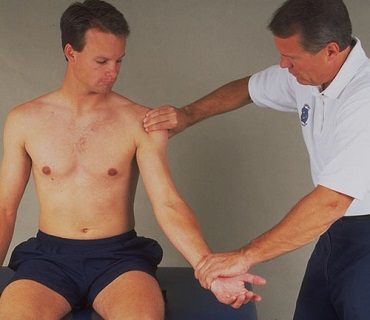
The best biceps tendonitis test is the Speed Test.
The patient starts with their arm straight, palm facing forwards and pushes the arm forwards and up against resistance.
The Speed Test is considered positive for bicipital tendonitis if this elicits pain in the bicipital groove.
Your doctor may send you for imaging tests such as an MRI, CT or ultrasound scan to identify and inflammation or damage to the tendon and/or rule out other shoulder pathologies.
#CommissionsEarned from Amazon on qualifying purchases
Biceps Tendonitis Treatment
Biceps tendonitis treatment will depend on the severity of the injury but usually involves the following:
1. Rest
Rest is the best place to start with biceps tendonitis treatment as it is really important to allow the tendon time to heal. Try and avoid any aggravating activities, particularly overhead activities and heavy lifting otherwise you are likely to interrupt and consequently slow the healing process
2. Ice Treatment
Regularly applying an ice pack to the shoulder helps to reduce the pain and inflammation in biceps tendonitis. When applied correctly, ice can also help speed up healing, but when used incorrectly it can actually make things worse. LEARN MORE >
3. Medication
Over the counter medications, particularly NSAIDs (non-steroidal anti-inflammatory drugs) such as ibuprofen/Advil and naproxen, can also help to reduce bicipital tendonitis pain and inflammation.
Always check with your doctor or pharmacist before taking any medications.
4. Steroid Injections
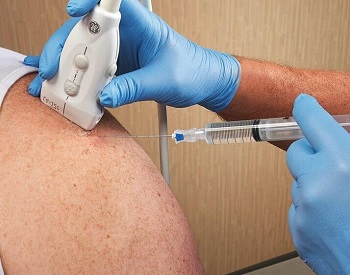
Corticosteroid injections into the damaged biceps tendon are a great treatment tool to reduce the pain and inflammation from biceps tendonitis.
A mixture of local anesthetic and steroid is injected directly into the damaged part of the biceps tendon and is best done under ultrasound guidance to ensure accurate location.
Care must be taken after steroid injections as they can temporarily weaken the biceps tendon making it prone to further damage or tearing. It is therefore important to take things easy for a few days after a steroid injection. LEARN MORE >
5. Physical Therapy
Your doctor shoulder refer you for physical therapy for your biceps tendonitis which will typically involve:
Strengthening Exercises
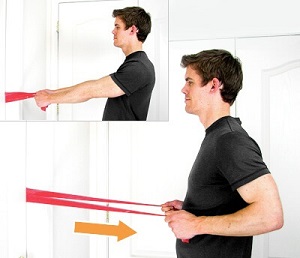
Your physio will give you a program of progressive rotator cuff strengthening exercises, usually starting with static (isometric) exercises then progressing on to active exercises followed by resistance band exercises.
It is important not to overload the damaged bicep tendon too soon, but also to put the right stresses and strains through the muscle as the tendon heals to ensure it regains full strength and flexibility, so be guided by your physio.
Stretching Exercises
The shoulder and upper arm can quickly stiffen up with bicep tendonitis so mobility and stretching exercises for the shoulder and arm muscles are important so you regain full range of motion. It can also help to do stretches that particularly target the biceps muscles - find out more in the biceps stretches section.
Again, your physio will be able to advise you on how to progress safely.
Deep Transverse Friction Massage
Your physio may carry out cross-friction massage which can help to reduce pain and inflammation in the biceps tendon as well as realign the tendon fibres as they heal.
Deep transverse friction massage is a specific type of massage directly transversely across the damaged tendon to increase blood flow, remove chemical irritants, decrease local inflammation and mobilise adhesive scar tissue. It is particularly effective with shoulder tendonitis.
Ultrasound
Ultrasound treatment, often used in combination with cross-friction massage, can help to reduce inflammation and speed up tissue healing with biceps tendonitis.
Therapeutic ultrasound helps to bring in the chemicals and nutrients needed for healing, takes away inflammatory chemicals that inhibit healing and helps to realign the tendon fibres as they heal.
6. Surgery
If symptoms of biceps tendonitis fail to settle with at least 3-months of conservative treatment, or if the tendon has completely torn (ruptured) then your doctor may advise shoulder surgery.
This usually involves a combination of shoulder impingement surgery e.g. subacromial decompression, surgery on the damage biceps tendon, and one of the following:
Biceps Tenotomy
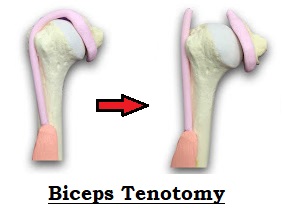
If the long head of biceps is severely damaged your surgeon may simply release the tendon from its attachment to the scapula i.e. cut it so it is no longer attached and leave it like that.
A biceps tenotomy tends to stop the pain but can result in a “Popeye bulge” in the upper arm as the muscle isn't stretched out as usual.
A tenotomy is the least invasive surgical option for bicipital tendonitis and is typically suited to people over the age of 60 who aren’t particularly active.
Biceps Tenodesis
Biceps tenodesis is usually done for severe tears or rupture.
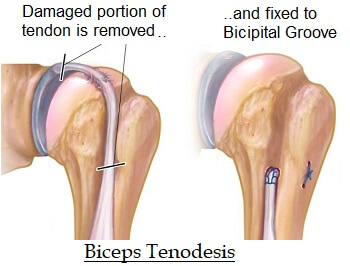
With a biceps tenodesis, the damaged portion of the biceps tendon is removed and the remaining tendon is attached to the bicipital groove or transverse humeral ligament either with screws or suture anchors.
Bicep Tenodesis surgery is more suitable for younger patients or more active people with biceps tendinitis.
Recovering From Surgery
Following surgery for biceps tendonitis you may need to use a sling for a few days/weeks. You will be able to use your hand immediately but some activities may be restricted initially to allow the tendon to heal properly.
You will work with a physical therapist on a rehab program to regain full strength and flexibility in your shoulder.
Most people make a full recovery from biceps tendonitis surgery, regaining full pain-free movement and strength in their shoulder.
Your Questions Answered
What Is The Biceps Tendonitis ICD-10 Code? The icd-10 code for Biceps Tendonitis/Bicipital Tendonitis is M75.22.
How Do I Know If I Have Bicipital Tendonitis? The most common symptom specific to bicep tendonitis is tenderness when you apply pressure over the bicipital groove at the front of the shoulder. It tends to be pretty tender there anyway so compare it to your other arm - you'll be able to tell the difference if there is a problem there! If not, it is likely something else that is causing your upper arm pain.
How Long Does It Take To Recover From Biceps Tendonitis? Recovery usually takes 6-12 weeks depending on how soon treatment is started and the severity of the damage. The longer the delay starting treatment, the longer the recovery process for biceps tendonitis is likely to be.
How Can I Prevent Biceps Tendonitis? The best way to prevent biceps tendonitis is to ensure you have good strength and mobility in the rotator cuff and shoulder blade muscles. The best way to do this is with rotator cuff exercises and scapular stabilisation exercises. If you are play a lot of sports particularly with repetitive overhead activities, then it is really important to ensure your technique is correct. Remember, prevention is better than cure!
What Else Can Help?
Most cases of biceps tendonitis will settle down in a few weeks with simple treatment such as rest, ice, exercises and bicep stretches.
Bicipital tendonitis often develops alongside other shoulder conditions which can make diagnosis difficult. Other shoulder conditions that present alongside or similar to upper arm pain from biceps tendinopathy include:
- Supraspinatus Tendonitis
- Shoulder Impingement Syndroms
- SLAP Tear
- Bankart Lesion
- Shoulder Bursitis
- Rotator Cuff Tear
If biceps tendonitis doesn't sound like your problem, check out the shoulder pain diagnosis section which will help you work out what is going on.
Related Articles
References
- Ortho Info: Biceps Tendonitis. American Academy of Orthopedic Surgeons. February 2016
- Cleveland Clinic: Biceps Tendon Injuries. October 2018
- American Family Physician: Diagnosis and Treatment of Biceps Tendinitis and Tendinosis. September 2009
Page Last Updated: November 5th, 2024
Next Review Due: November 5th, 2026

